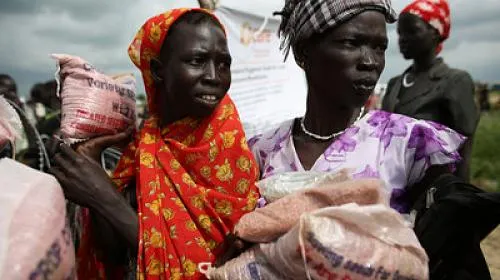NGOs urge regional leaders and donors to redouble efforts to push for a lasting peace agreement that transforms South Sudan’s trajectory from devastation to development
NAIROBI-February 9, 2015 – As regional leaders, donor countries and outgoing UN Humanitarian Chief Valerie Amos meet at a pledging conference today for the second time since conflict began in South Sudan in December 2013, tough decisions must be made, said a coalition of nongovernmental organizations(NGOs). If these influential parties don’t do more to urge South Sudan’s warring leaders to address the core drivers of their conflict, aid will remain merely an expensive band-aid solution, and millions more will be pushed into hunger in the coming year.
While financial contributions are essential, parties attending Monday’s meeting must use their influence to ensure that any peace agreements made are lasting. They must also ensure plans are put in place to meet the basic needs of the millions of victims of the violence – both within South Sudan and in neighboring countries. Integral to this is a reconciliation process focused at reuniting divided communities.
This conflict has resulted in the suffering of millions of South Sudanese –thousands are believed to have died, 2.5 million are experiencing severe hunger, and a further half a million have fled to neighboring countries out of fear for their lives.
“Multiple peace agreements and ceasefire promises have been made and subsequently broken in both Addis Ababa and Arusha, while the people of South Sudan continue to suffer. As the fighting continues and leaders fail to reach a lasting commitment for peace, the intervention of regional leaders, donors and other actors becomes ever more urgent,” said Oxfam Regional Director Nigel Tricks.
With so many other conflicts raging across the globe, South Sudan is in danger of being forgotten at a time when aid operations are critical – both in the country and regionally. To adequately respond to the most urgent needs, $1.8 billion is needed in 2015 – a third, or $600 million, is needed before the end of the dry season in April to pre-position stocks before the rains make parts of the country impenetrable.
“As outgoing UN Humanitarian Chief Valerie Amos makes her last visit to South Sudan, we have a rare moment where the world is watching. Those attending the pledging conference must give their fair share to ensure the people affected by conflict in this young nation do not continue to go hungry; that they feel safe enough to return to their homes; that parents can send their children to school,” said Danish Refugee Council Regional Director Heather Amstutz.
Children and women have bore the brunt of the South Sudan conflict, with an estimated half a million children dropping out of school since December 2013 and alarming levels of sexual violence against women. Over 11,000 boys have been recruited to fight in this bloody war, sacrificing their childhood for a fight that is not their own. Women make up the vast majority of people in refugee camps in neighboring countries – as many as 80 percent in Gambella, Ethiopia, as well as in displacement camps in South Sudan.
UN Sexual Violence Envoy Zainab Bangura described the violence against women that she witnessed in South Sudan during an October 2014 visit as the worst she had ever seen in her “30 years in public service and in the UN and as a government minister,” in a Voice of America interview.
Media contact
Holly Frew +1.404.979.9389 hfrew@care.org
About CARE
Founded in 1945, CARE is a leading humanitarian organization fighting global poverty. CARE has more than six decades of experience helping people prepare for disasters, providing lifesaving assistance when a crisis hits, and helping communities recover after the emergency has passed. CARE places special focus on women and children, who are often disproportionately affected by disasters. To learn more, visit www.care.org.

